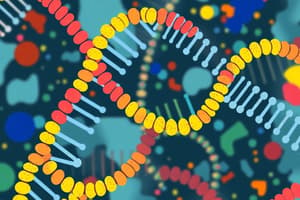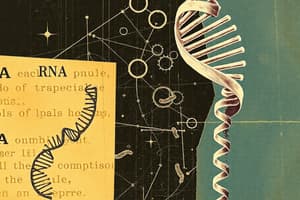Podcast
Questions and Answers
What is the process of copying a segment of DNA into RNA called?
What is the process of copying a segment of DNA into RNA called?
- Translation
- Duplication
- Replication
- Transcription (correct)
What percentage of the human genome can be transcribed into mRNA?
What percentage of the human genome can be transcribed into mRNA?
- Less than 2% (correct)
- Exactly 50%
- More than 10%
- Around 5%
What type of RNA molecule encodes proteins?
What type of RNA molecule encodes proteins?
- rRNA
- tRNA
- snRNA
- mRNA (correct)
During transcription, what breaks the hydrogen bonds between complementary DNA nucleotides?
During transcription, what breaks the hydrogen bonds between complementary DNA nucleotides?
What forms the RNA sugar-phosphate backbone during transcription?
What forms the RNA sugar-phosphate backbone during transcription?
What is the primary transcript produced during transcription?
What is the primary transcript produced during transcription?
Which molecule reads the DNA sequence during transcription?
Which molecule reads the DNA sequence during transcription?
What is the role of general transcription factors in transcription?
What is the role of general transcription factors in transcription?
What percentage of total RNA samples does messenger RNA (mRNA) comprise?
What percentage of total RNA samples does messenger RNA (mRNA) comprise?
What happens if the cell has a nucleus after transcription?
What happens if the cell has a nucleus after transcription?
What is the role of non-coding RNAs (ncRNAs) in transcription?
What is the role of non-coding RNAs (ncRNAs) in transcription?
Which nucleic acid uses base pairs of nucleotides as a complementary language?
Which nucleic acid uses base pairs of nucleotides as a complementary language?
During transcription, what forms the RNA sugar-phosphate backbone with assistance from RNA polymerase?
During transcription, what forms the RNA sugar-phosphate backbone with assistance from RNA polymerase?
What process separates the two strands of the DNA helix during transcription?
What process separates the two strands of the DNA helix during transcription?
What percentage of mammalian genomic DNA can be actively transcribed in one or more types of cells?
What percentage of mammalian genomic DNA can be actively transcribed in one or more types of cells?
Flashcards are hidden until you start studying
Study Notes
Transcription Process
- The process of copying a segment of DNA into RNA is called transcription.
- During transcription, the enzyme helicase breaks the hydrogen bonds between complementary DNA nucleotides.
RNA Molecules
- Messenger RNA (mRNA) is a type of RNA molecule that encodes proteins.
- Messenger RNA (mRNA) comprises only about 5% of total RNA samples.
- Non-coding RNAs (ncRNAs) play a crucial role in transcription, but do not encode proteins.
RNA Synthesis
- The RNA sugar-phosphate backbone is formed during transcription, with assistance from RNA polymerase.
- The primary transcript produced during transcription is a precursor to mature RNA.
Transcription Initiation
- General transcription factors play a crucial role in transcription by recruiting RNA polymerase to the gene promoter.
- RNA polymerase reads the DNA sequence during transcription.
Cellular Compartmentalization
- After transcription, if the cell has a nucleus, the RNA is transported out of the nucleus into the cytoplasm for translation.
DNA Structure
- DNA uses base pairs of nucleotides as a complementary language.
- The process of separating the two strands of the DNA helix during transcription is called helicase-mediated unwinding.
Genome Transcription
- Approximately 90% of the human genome can be transcribed into mRNA.
- About 80% of mammalian genomic DNA can be actively transcribed in one or more types of cells.
Studying That Suits You
Use AI to generate personalized quizzes and flashcards to suit your learning preferences.




